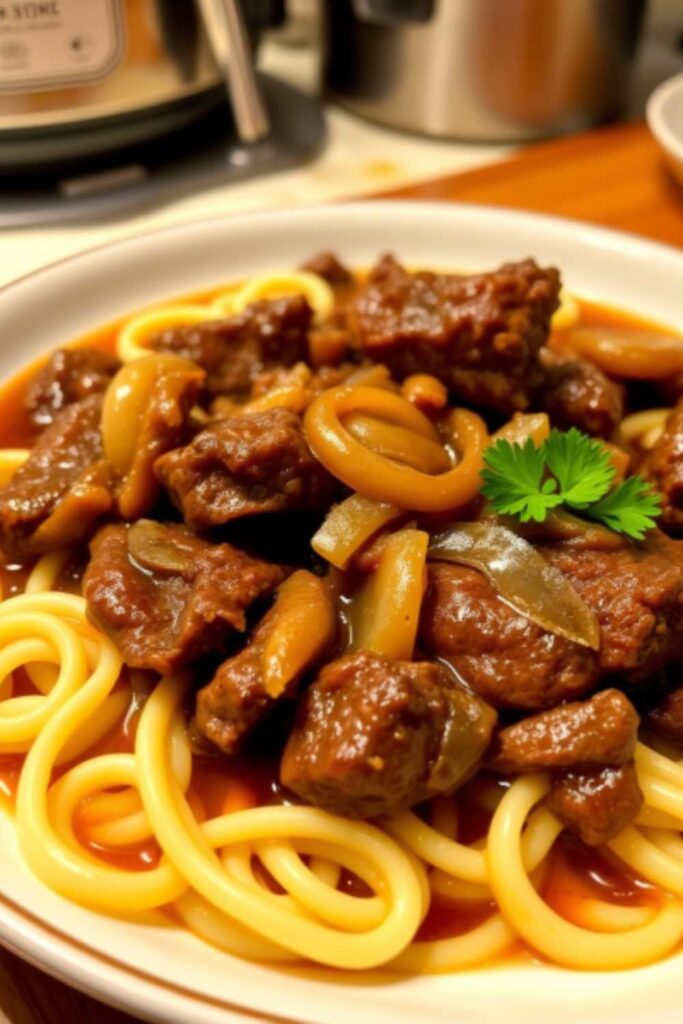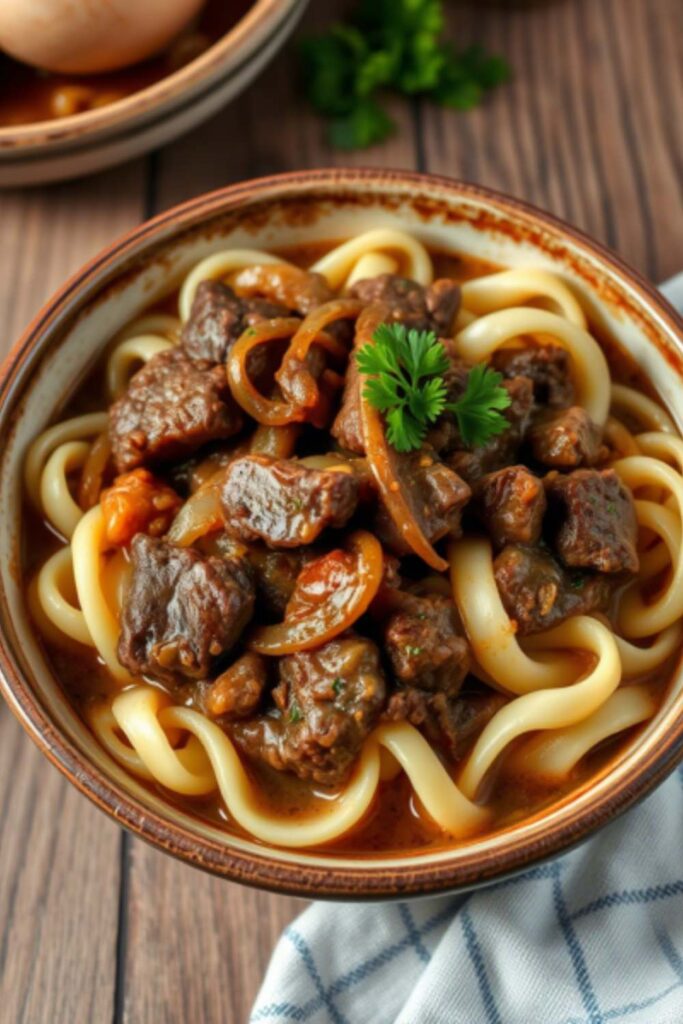Have you ever taken a bite of a dish that felt like a warm hug? That’s exactly how I feel about French Onion Beef and Noodles. The rich, savory flavors of caramelized onions combined with tender beef and noodles create a symphony of taste that’s hard to resist. This dish isn’t just a meal; it’s an experience. There’s something so comforting about it, especially on a chilly evening.
This recipe is special because it marries the classic French onion soup flavors with hearty beef and noodles. It’s like a fusion of two beloved dishes, creating a comforting, filling meal that’s sure to please. The unique layers of flavor—from sweet, caramelized onions to the rich beef broth—make it a standout. Let’s dive in.
Ingredients & Substitutions
Here’s a comprehensive list of what you’ll need. I’ll also share some substitutions for dietary needs and preferences.
- Beef (Chuck roast or sirloin): Choose well-marbled cuts for tenderness. If you prefer leaner meat, opt for flank steak.
- Onions: Yellow or sweet onions work best. Red onions can add a twist, but they’re not as sweet.
- Garlic: Fresh is best, but feel free to use minced if you’re in a pinch.
- Beef broth: Homemade is ideal for richness, but low-sodium store-bought works too.
- Egg noodles: Wide egg noodles are traditional, but you can swap for whole wheat or gluten-free varieties.
- Butter: Unsalted is preferable for better control over seasoning. Olive oil can work in a pinch.
- Thyme: Fresh thyme adds depth. Dried is fine, but use less since it’s more concentrated.
- Bay leaves: Don’t skip this! They add a subtle layer of flavor.
- Salt & Pepper: Always taste as you go.
- Cheese (Gruyère or Swiss): For that gooey top. You can use mozzarella for a milder flavor.
When picking ingredients, opt for fresh herbs if you can. They bring brightness that dried can’t quite match.
Step-by-Step Instructions

Let’s break down how to make this dish. I’ll keep it simple and straightforward.
- Prepare the Beef: Season your beef generously with salt and pepper. Heat a large pot or Dutch oven over medium-high heat. Add a bit of butter and sear the beef on all sides until browned. This locks in those juices. Don’t overcrowd the pot; work in batches if necessary.
- Sauté the Onions: Remove the beef and set it aside. In the same pot, add more butter if needed and toss in the sliced onions. Cook them low and slow, stirring occasionally until they’re golden brown. This caramelization is key. It can take about 20-30 minutes, but trust me, it’s worth it.
- Add Garlic and Herbs: Once the onions are nicely caramelized, add minced garlic, thyme, and bay leaves. Cook for another minute until fragrant.
- Deglaze: Pour in a splash of beef broth to scrape up any browned bits from the bottom of the pot. That’s where the flavor’s at!
- Combine: Return the beef to the pot, add the remaining broth, and bring it to a gentle simmer. Cover and let it cook for about 1.5 to 2 hours until the beef is fork-tender.
- Cook the Noodles: While the beef is cooking, prepare your egg noodles according to package instructions. Drain and set aside.
- Mix & Serve: Once the beef is ready, remove it from the pot and shred it. Return it to the pot along with the cooked noodles. Stir everything together, taste for seasoning, and adjust as necessary.
- Cheese It Up: For the final touch, ladle the mixture into oven-safe bowls, top with cheese, and broil until bubbly and golden.
Common Mistakes to Avoid
- Not caramelizing the onions enough: Rushing this step can lead to a flatter flavor.
- Overcooking the noodles: They’ll continue to cook when mixed with the hot beef mixture.
- Skipping the deglazing step: Those brown bits are flavor gold—don’t leave them behind!
Variations
Want to spice things up? Add a teaspoon of cayenne for some heat. Feeling adventurous? Toss in some mushrooms with the onions for an earthy touch.
Cooking Techniques & Science

Understanding the “why” behind techniques can elevate your cooking.
Searing the Beef: This method builds flavor through the Maillard reaction. Browning meat creates a depth that simmering alone can’t achieve.
Caramelization: Cooking onions slowly allows their natural sugars to develop. This process transforms the sharpness of raw onions into sweet, complex flavor.
Deglazing: This technique not only cleans the pan but also captures all those flavorful bits stuck to the bottom.
Tools You’ll Need
A good Dutch oven is key. It ensures even heat distribution, which is crucial for slow cooking. A sharp knife for slicing onions will save you time and effort.
Serving & Pairing Suggestions
Presentation matters! Serve this dish in rustic bowls topped with melted cheese. A sprinkle of fresh thyme or parsley adds a pop of color.
For sides, consider a simple green salad dressed with vinaigrette. A crusty baguette is perfect for soaking up the rich broth. As for drinks, a glass of robust red wine pairs beautifully, complementing the dish’s depth.
Conclusion
French Onion Beef and Noodles is more than just a meal; it’s a cozy experience that brings warmth and comfort. The combination of tender beef, sweet onions, and rich broth creates a dish that’s hearty yet refined.
Remember, patience is key. The longer you allow the flavors to meld, the better it will taste. Don’t hesitate to experiment and make it your own.
Final Expert Tips
- Always taste as you go. Adjust seasoning based on your personal preference.
- If leftovers are in your future, store the noodles separately. They can absorb too much broth if left together.
FAQs
1. Can I make this dish ahead of time?
Absolutely! It actually tastes better the next day as the flavors develop.
2. What if I don’t have egg noodles?
You can use any pasta you have on hand. Just adjust cooking times accordingly.
3. How do I store leftovers?
Keep them in an airtight container in the fridge for up to three days. Reheat gently on the stove.
4. Can I freeze this dish?
Yes! It freezes well. Just make sure to freeze without the noodles.
5. What can I use instead of beef?
You can substitute with chicken or even make a vegetarian version using mushrooms and vegetable broth.
This dish is a timeless classic, and with these tips, you’ll be well on your way to mastering it. Enjoy the process and the delicious results!








